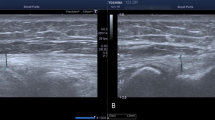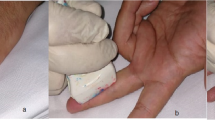Abstract
Purpose
To compare agreement between conventional B-mode ultrasound (US) and compression sonoelastography (SEL) of the common extensor tendons of the elbow with histological evaluation.
Materials and methods
Twenty-six common extensor tendons were evaluated in 17 cadavers (11 females, median age 85 years and 6 males, median age 80 years). B-mode US was graded into: Grade 1, homogeneous fibrillar pattern; grade 2, hypoechoic areas and/or calcifications <30%; and grade 3 > 30%. SEL was graded into: Grade 1 indicated blue (hardest) to green (hard); grade 2 yellow (soft); and grade 3 red (softest). B-mode US, SEL, and a combined grading score incorporating both were compared to histological findings in 76 biopsies.
Results
Histological alterations were detected in 55/76 biopsies. Both modalities showed similar results (sensitivity, specificity, and accuracy 84%, 81%, and 83% for B-mode US versus 85%, 86%, and 86% for SEL, respectively, P > 0.3). However, a combination of both resulted in significant improvement in sensitivity (96%, P < 0.02) without significant change in specificity (81%, P < 0.3), yielding an improved overall accuracy (92%).
Conclusion
Combined imaging of the extensor tendons with both modalities is superior to either modality alone for predicting the presence of pathologic findings on histology.
Key Points
• Combination of B-mode US and SEL proved efficiency in diagnosing lateral epicondylitis.
• Combination of B-mode US and SEL in lateral epicondylitis correlates to histology.
• Combination of both modalities provides improved sensitivity without loss of specificity.



Similar content being viewed by others
Abbreviations
- LE:
-
Lateral epicondylitis
- SEL:
-
Sonoelastography
- US:
-
Ultrasound
- MSK:
-
Musculoskeletal
- B-mode US:
-
B-mode ultrasound
- ROI:
-
Region of interest
References
Connell D, Burke F, Coombes P et al (2001) Sonographic examination of lateral epicondylitis. AJR 176:777–82
Miller TT, Shapiro MA, Schultz E, Kalish PE (2002) Comparison of sonography and MRI for diagnosing epicondylitis.JClin. Ultrasound 30:193–202
Levin D, Nazarian LN, Miller TT et al (2005) Lateral epicondylitis of the elbow: US findings. Radiology 237:230–4
Jaen-Diaz JI, Cerezo-Lopez E, Lopez-de CF et al (2010) Sonographic findings for the common extensor tendon of the elbow in the general population. J Ultrasound Med 29:1717–24
Shiri R, Viikari-Juntura E, Varonen H, Heliovaara M (2006) Prevalence and determinants of lateral and medial epicondylitis: a population study. Am J Epidemiol 164:1065–74
Walz DM, Newman JS, Konin GP, Ross G (2010) Epicondylitis: pathogenesis, imaging, and treatment. Radiographics 30:167–84
Latham SK, Smith TO (2014) The diagnostic test accuracy of ultrasound for the detection of lateral epicondylitis: a systematic review and meta-analysis. Orthop Traumatol Surg Res 100:281–6
De Zordo T, Lill SR, Fink C et al (2009) Real-time sonoelastography of lateral epicondylitis: comparison of findings between patients and healthy volunteers. AJR 193:180–5
Dones VC III, Grimmer K, Thoirs K, Suarez CG, Luker J (2014) The diagnostic validity of musculoskeletal ultrasound in lateral epicondylalgia: a systematic review. BMC Med Imaging 14:10
Havre RF, Elde E, Gilja OH et al (2008) Freehand real-time elastography: impact of scanning parameters on image quality and in vitro intra- and interobserver validations. Ultrasound Med Biol 34:1638–50
Klauser AS, Miyamoto H, Bellmann-Weiler R, Feuchtner GM, Wick MC, Jaschke WR (2014) Sonoelastography: musculoskeletal applications. Radiology 272:622–33
Klauser AS, Faschingbauer R, Jaschke WR (2010) Is sonoelastography of value in assessing tendons? Semin Musculoskelet Radiol 14:323–33
Ahn KS, Kang CH, Hong SJ, Jeong WK (2014) Ultrasound elastography of lateral epicondylosis: clinical feasibility of quantitative elastographic measurements. AJR 202:1094–9
Ooi CC, Malliaras P, Schneider ME, Connell DA (2014) “Soft, hard, or just right” applications and limitations of axial-strain sonoelastography and shear-wave elastography in the assessment of tendon injuries. Skelet Radiol 43:1–12
Kocyigit F, Kuyucu E, Kocyigit A et al (2016) Association of real-time sonoelastography findings with clinical parameters in lateral epicondylitis. Rheumatol Int 36:91–100
Klauser AS, Miyamoto H, Tamegger M et al (2013) Achilles tendon assessed with sonoelastography: histologic agreement. Radiology 267:837–42
Miyamoto H, Halpern EJ, Kastlunger M et al (2014) Carpal tunnel syndrome: diagnosis by means of median nerve elasticity--improved diagnostic accuracy of US with sonoelastography. Radiology 270:481–6
Giyoung P, Dongrak K, Junghyun P (2014) Diagnostic confidence of sonoelastography as adjunct to greyscale ultrasonography in lateral elbow tendinopathy. Chin Med J 127:3110–5
Khoury V, Cardinal É (2009) “Tenomalacia”: a new sonographic sign of tendinopathy? Eur Radiol 19:144–6
Rosskopf AB, Ehrmann C, Buck FM, Gerber C, Fluck M, Pfirrmann CW (2016) Quantitative shear-wave US elastography of the supraspinatus muscle: reliability of the method and relation to tendon integrity and muscle quality. Radiology 278:465–74
Acknowledgements
The scientific guarantor of this publication is Andrea S Klauser. The authors of this manuscript declare no relationships with any companies, whose products or services may be related to the subject matter of the article. The authors state that this work has not received any funding. One of the authors has significant statistical expertise. Institutional Review Board approval was not indicated as this work was conducted on cadavers, who dedicated their bodies for research after death according to their will and they signed this consent form before death. Written informed consent was obtained from all subjects in this study. Methodology: Prospective, Diagnostic or prognostic study, Performed at one institution.
Author information
Authors and Affiliations
Corresponding author
Rights and permissions
About this article
Cite this article
Klauser, A.S., Pamminger, M., Halpern, E.J. et al. Extensor tendinopathy of the elbow assessed with sonoelastography: histologic correlation. Eur Radiol 27, 3460–3466 (2017). https://doi.org/10.1007/s00330-016-4711-x
Received:
Revised:
Accepted:
Published:
Issue Date:
DOI: https://doi.org/10.1007/s00330-016-4711-x




